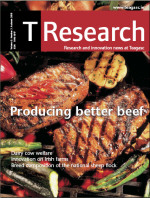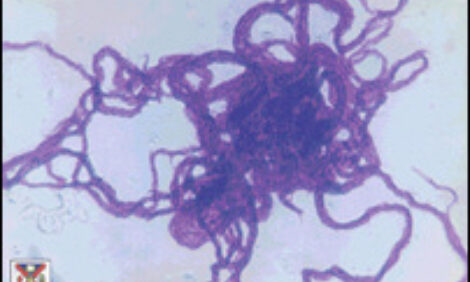



Tackling Dairy Cow Welfare Issues
Laura Boyle and Gabriela Olmos describe their work on elucidating the advantages of grass-based dairy systems from an animal welfare perspective, thereby increasing the competitiveness of the dairy industry. This article, a product of the Irish Agriculture and Food Development Authority, was published in the T Research magazine Volume 3, Number 3, Autumn 2008.Dairy farming is relatively free of constraints imposed by animal welfare legislation, but this is likely to change in the future. Currently, the European Food Safety Authority (EFSA) is compiling a report on the welfare of dairy cows.
According to Professor Don Broom, Chairman of the EFSA dairy cow welfare working group, it is likely that an EU Directive on the welfare of dairy cows will follow. Such legislation could constrain the way in which cows are fed, managed and housed. Additionally, aspects of genetic selection could be restricted and pressure is likely to be placed on milk producers to allow cows access to pasture. In most EU countries, cows are housed all year round, whereas in Ireland cows are at grass for between six and 10 months of the year.
In this respect, the Irish dairy industry could have a significant advantage over its European counterparts if legislation insisting on access to pasture is enforced. However, this does not mean that we can be complacent when it comes to dairy cow welfare, because cows in pasture-based systems can still suffer poor welfare. In light of future constraints on dairying practices, a proactive approach to cow welfare is crucial. Such an approach should involve an evaluation of the potential welfare implications of the technical innovations identified as important for the sustainability of dairying in Ireland. These innovations include:
- using genetic selection incorporating fitness and other traits relevant for cows in pasture-based systems of milk production;
- maximising utilisation and performance from grazed grass;
- developing low fixed-cost systems to allow dairy farmers to expand; and,
- developing labour-efficient systems of production.
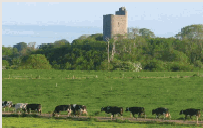 |
| Walking on farm roadways is a major risk factor for lameness in cows in grass-based production systems. |
At Moorepark, during a five-year research programme on dairy cow welfare, several aspects of these innovations were assessed. Dairy cow welfare was evaluated using a diverse range of measurements, encompassing behaviour, health (including mastitis and lameness), fertility, stress physiology and immune function. The range of measurements used reflects the challenges associated with measuring animal welfare; single indicators are inadequate to measure such a complex issue.
Genetic selection
In the past, genetic selection within the Holstein-Friesian breed was exclusively on the basis of milk yield and this had detrimental implications for fertility, health and, ultimately, for cow survival. The Irish Economic Breeding Index (EBI) attempts to address this problem by including traits such as survival, fertility and health, as well as selection for higher milk solids, the latter being more relevant than milk yield in grass-based milk production systems. For this reason, selection for high EBI genetics should result in cows that are fertile, show a low incidence of disease and that ultimately have good welfare and longevity in our milk production systems.
Lameness
After mastitis, lameness is the second most important cause of poor longevity in dairy cows. It is also the major welfare problem of dairy cows because of the pain it causes. Previous research at Moorepark showed that the average number of animals that became lame per six-month period (January to June or July to December) on 14 commercial dairy farms was between 12 and 16 per 100 cows. However, on individual farms, the figure could be as high as 31 per 100 cows during any six-month period, which indicates the extent of the problem. We evaluated indicators of lameness in cows from three genetic strains; two were classified as high EBI but had either North American (NA) or New Zealand (NZ) ancestry, and the third was of low EBI with NA ancestry. We found that, irrespective of their ancestry, higher EBI cows had equal or improved locomotion ability, less severe hoof disorders and less clinical lameness than animals of lower genetic potential.
Fertility, health and immune function
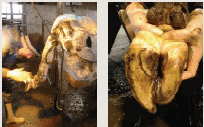 |
| After mastitis, lameness is the second most important cause of poor longevity in dairy cows. It is also the major welfare problem of dairy cows because of the pain it causes. |
We also investigated fertility, health and immune function in these animals during the peripartum and early lactation period. During this time, dairy cows are particularly susceptible to poor welfare caused by stress and disease – ultimately leading to reproductive problems. Our studies indicate that high EBI cows tend to have lower somatic cell scores and fewer mastitis problems at calving. However, while disease and fertility outcomes were similar for high EBI cows of either NA or NZ ancestry, they had different physiological strategies for coping with the stresses associated with calving. Considering that the ancestors of these cows were selected in different environments (i.e., NZ=pasture vs. NA=confinement) and, hence, with different breeding goals, these differences could reflect inherited peripartum adaptation strategies. A greater understanding of such differences will be required in order to avoid any deleterious effects arising from the use of high EBI genetics.
While the outlook for the EBI in terms of improving cow health is good, selection for high EBI could have an unforeseen impact on other correlated traits that influence cow welfare. For example, research conducted in the UK showed that dairy cows from sires that scored high for health, fertility and survival were more aggressive at feeding than cows from sires that scored low for these traits. In Ireland, to date, there has been no research on the effect of selective breeding on aspects of behaviour that influence cow welfare.
Maximising utilisation and performance from grazed grass
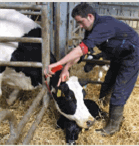 |
| Increasingly large herd sizes and fewer labour units mean that the periparturient cow could get less attention at a time when she is at her most vulnerable. |
In Ireland, the cheapest and most efficient way of producing milk is from grazed grass. The welfare advantages associated with this system of milk production compared to confinement-based systems are significant. Initial results from a trial conducted at Moorepark indicate that the prevalence of lameness in cows at grass was 17%, compared to 42% indoors, while the prevalence of mastitis was 35% in cows at grass, compared to 65% indoors. Furthermore, cows at grass showed better locomotory ability, lay down for longer and, ultimately, had fewer reproductive disorders compared to cows kept indoors. These findings help to strengthen the potential advantage Irish dairy producers will have over their European counterparts if legislation implementing access to pasture is enforced in the future.
Nevertheless, new strategies to maximise the utilisation of, and performance from, grazed grass in the diet could have negative welfare implications for dairy cows. We found that the hoof health of dry cows out-wintered on deferred grass was poorer compared to cows that were housed during the winter. Furthermore, we noticed deterioration in the hoof health of lactating cows that were at grass late in the autumn. There are several possible explanations for these findings. Firstly, extended grazing (where lactating cows are turned out early in the spring and are at grass for longer in the autumn) and, secondly, out-wintering dry cows on deferred grass means that animals are outside when the weather is poor in paddocks that are often unsheltered. This, combined with wet, muddy underfoot conditions, deters cows from lying down. Prolonged standing is not only a major stressor of dairy cows but also contributes to hoof problems. Furthermore, exposure to high levels of rainfall can cause the hooves to soften, which makes them more susceptible to injury, particularly if the cows have to walk on muddy roadways. Clearly, strategies to maximise the use of grazed grass need to be developed, in conjunction with research on shelter options for cows at pasture, and alternative materials for farm roadways to minimise lameness.
Developing low fixed-cost systems
One of the main low fixed-cost systems evaluated at Moorepark and other Teagasc centres during the past few years, was out-wintering pads (OWPs). OWPs allow most classes of beef and dairy cattle to be kept outdoors during the winter in a free draining area on a bed of woodchips. Given the costs associated with cubicle housing for dairy animals, they are a key feature in the expansion of a dairy herd. As previously mentioned, keeping dairy animals outdoors during periods of bad weather has implications for welfare.
Our findings suggest, however, that (at least in the north Cork region) the risk of cold stress during the winter is minimal, although periods of wet and windy weather cause cows to spend less time lying down than they would in cubicles. Cows on OWPs also have softer hooves compared to animals indoors and this can have negative implications for hoof health once the cows recommence walking to and from the parlour for milking. However, we found little difference in the incidence of lameness during the winter period. In replacement dairy heifers, OWPs were also associated with behavioural indicators of good welfare, such as an increased incidence of play and comfort behaviours.
OWP heifers also suffered fewer leg injuries than heifers indoors. These benefits were attributed to higher space allowances and more comfortable underfoot conditions compared to cubicle accommodation. Certainly, when management is good, the woodchips are cleaned regularly and shelter is provided, OWPs have the potential to improve the welfare of dairy animals over conventional systems. This is good news for producers wishing to increase.
Developing labour-efficient systems of production
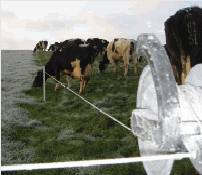 |
| In most EU countries cows are housed all year round, whereas in Ireland cows are at grass for between six and 10 months of the year. |
In Ireland, where herd sizes are increasing and there is a shortage of people willing to work on dairy farms, labour-efficient systems of production are crucial factors affecting expansion and sustainability. In the future, the EBI should help to ensure that dairy workers will not need to spend excessive amounts of time trying to get their cows in calf, in nursing them through illnesses or in treating lameness. This will contribute to improved labour efficiency on dairy farms. However, one area of concern is in the care of cows (and their calves) during the calving season. Grass-based milk production systems are characterised by a highly seasonal calving pattern, meaning that all the cows ideally calf within a few weeks of each other. However, unlike grass-based systems in New Zealand, where cows generally calve at grass with little or no supervision, calving in Ireland is highly managed, i.e., the cows calve indoors under supervision. This, combined with increasingly large herd sizes and fewer labour units, means that the periparturient cow is likely to get less attention at a time when she is at her most vulnerable. There is likely to be a minimum below which the number of labour hours per cow per year cannot be reduced without welfare implications.
Once-a-day milking
A labour-efficient system of milk production that was comprehensively evaluated at Moorepark was once-a-day (OAD) milking. OAD milking is of interest to a niche group of farmers, particularly those with off-farm employment. The dairy cow welfare team worked together with researchers investigating effects on milk production, quality and processability, to determine the welfare implications of this practice. We found that, towards the end of the grazing season, hoof health in cows milked once a day was superior to that of cows milked twice a day.
We attributed this to the 50% reduction in walking to and from the parlour for milking. In early to peak lactation, however, OAD milking had some negative implications, as the cows suffered from discomfort caused by udder distension. This was reflected in abnormal locomotion, disturbed lying patterns, milk leakage and a detrimental effect on the functionality of cells of the immune system. Indeed, the latter finding suggests that there may have been some psychological stress associated with the practice. Cows will voluntarily enter automatic milking systems up to three times per day, suggesting that they ‘prefer’ to be milked more frequently, particularly in the period up to peak lactation.
Future
We are in an era of increased public awareness about farm animal welfare. Therefore, public acceptance of the breeding, feeding and management practices employed in the dairy industry is crucial. This, combined with tighter restrictions on dairying through EU animal welfare legislation, means that there will be a substantially increased need for work on dairy cow welfare in general and, particularly, on dairy cow welfare in pasture-based systems of milk production.
This research was funded by The Dairy Levy, the National Council for Forest Research and Development (COFORD) and the National Development Plan.
August 2008

